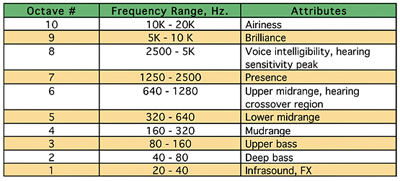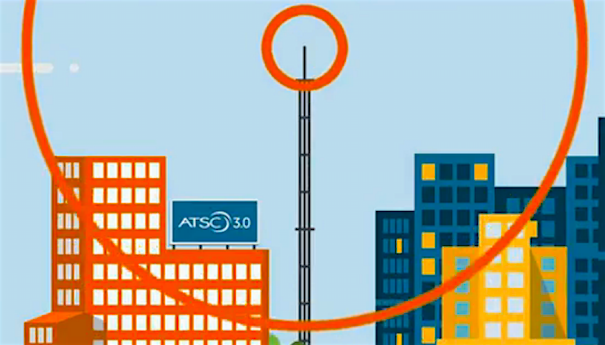Spectral Management: Organizing Multitrack EQ

This is my final column in this series on equalization. I've tried to take you through some of the basics of this quirky and difficult craft, including the concept of timbre and overtones, the principles of narrowly deleting "bad" sonic resonances (cutting) and then broadly enhancing sonic goodnesses (boosting).
In this column I'd like to discuss a concept I call spectral management, which refers to a process for allocating parts of the spectrum to different instruments and voices. This process, done well, will have the happy effect of making your mixes clearer, more transparent, a little louder for a given maximum level and generally a little "nicer" sounding (whatever that means).
In the first article in this series (April 1), I included a cheat sheet describing various attributes of the ten octaves of spectrum that we hear. I recommend you dig through your back issues and find it. In case you're too lazy, the dog ate it or some miscreant threw it out, see Fig. 1, which provides a brief review of those essentials.
Almost all sounds contain energy in at least six of those octaves. Octaves 7–10 are almost exclusively overtones. Octave 1 has almost no useful information, even though it is quite dramatic and a lot of fun to mess around with. Unfortunately, it is not reproduced well by many loudspeakers. Octaves 2 and 3 provide critical bass energy and need great care, attention and aesthetic nourishment. They are tender and touchy.
Because almost all sounds have energy in almost all octaves, there can be conflicts between sounds, particularly as we begin to boost. Bands of energy from the acoustic guitar track can conflict with bands of energy from the trumpet track, which in turn can conflict with bands of energy from the voice track, which then can conflict with bands of energy from the motorcycle FX track, which, of course, conflicts with the acoustic guitar track, coming full circle.
As you EQ the guitar track and get it sounding pretty good, you begin to notice you can't hear the motorcycle, the trumpet or the voice tracks anymore. So you turn up the trumpet track and the motorcycle, destroying the voice track and rendering the good EQ you had on the acoustic guitar track basically inaudible. What's a body to do?
GETTING OUR PRIORITIES STRAIGHT
This is where spectral management comes in. First, you prioritize your tracks. For example, you decide that voice is most important, trumpet and acoustic guitar are tied for second and motorcycle is last. Start by EQing the voice track, probably boosting the eighth octave (ca. 4 kHz.) for intelligibility and clarity on the voice.
Second, you now declare this octave band more or less off-limits for the other tracks, which is to say, don't boost Octave 8 on the trumpet, acoustic guitar or motorcycle tracks. But you know that you especially like Octave 8 boosted on the acoustic guitar. What to do?
Well, you boost Octave 7 instead—it's adjacent, has many similar qualities, and it doesn't fight with the voice boost you've done on Octave 8. What you'll notice is that you get that acoustic guitarness just fine, and the EQ certainly won't sound bad, while the combination of the two tracks, voice and guitar, sound better than they would if booth were boosted in Octave 8. Interesting, eh?
Moving right along, for the trumpet track you try boosting Octave 9, to pull up its metallic, brassy brilliance. It won't be quite as fat as you might have liked, but it'll be brassy and it'll mix better as well.
Finally, the motorcycle. I'm assuming it's a Harley, very broadband. You might add a little of Octave 9 (see below for why), some Octave 10 for the edge of the individual exhaust explosions, and some boost in Octave 3 and Octave 5, to fill in the classic fullness of that wonderful Hog sound. You can evoke it really well, while leaving the bespoke octaves available for their instruments.

Fig 1. The 10 octaves of the audio spectrum, including frequency ranges and a few attributes of each octave.TRANSIENTS VS. SUSTAINED SOUNDS
The reason it's okay to have both the motorcycle and the trumpet boost in Octave 9 is the difference in their temporal character. The trumpet is sustained, while the Harley's sound is all impulses, also known as transients. Because of this difference in their time character, neither masks the other.
This also means you can EQ percussion using frequency bands that are shared with other instruments. Kick drum often needs some boost in the 4–8 kHz range, while snare may need both some 2 kHz and also maybe some 250 Hz.
These won't interfere much at all with the more sustained timbres of voice, trumpet and guitar, for example, occupying those ranges as well. Use your ears here. It's an art, not a science.
WHAT DOES IT ALL MEAN?
Checking how your EQ is working needs to be done "in mix context," which means that you make your final decisions and tweaks while listening to everything in the mix.
It's okay to start out by EQing while listening to individual tracks. However, you need to satisfy yourself that they sound okay while listening in mix context. Better they should all sound good together than they should all sound absolutely fabulous on their own with little regard to how they sound together in the overall mix.
So, there you have it: a brief little primer on equalization. To do it well you will have to practice—really learn to listen carefully and pull apart the frequency spectrum in your ears. As you get good at that, then these processes will help you begin to quickly and effectively get much better sounds and mixes than you ever could before.
Thanks for listening.
Dave Moulton is trying to manage the spectrum of one hand clapping. You can complain to him about anything at his website, www.moultonlabs.com. There's more about this topic atwww.moultonlabs.com/more/spectral_management/. Enjoy!
The professional video industry's #1 source for news, trends and product and tech information. Sign up below.

